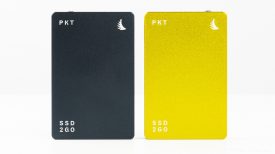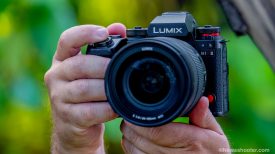By site editor Dan Chung:
If you were a fan of the re-imagined Battlestar Galactica then you might be forgiven for thinking that you have seen the DJI OSMO before. The integrated 4K camera and brushless gimbal look just like the kind of futuristic camera that news reporters use in sci-fi movies. Like the iPhone and iPad, this is another case of science fiction becoming reality. I don’t think it will be too long before we see the first OSMOs popping up in front of the other cameras at big news events – probably to the annoyance of traditional news camera operators.
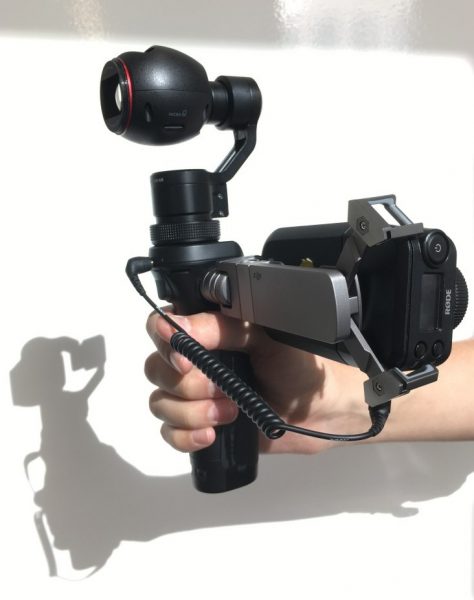
The OSMO is essentially your choice of either X3 or X5 Pro camera from DJI’s Inspire 1 quadcopters, married with a custom handheld stabiliser. The X3 is a fixed lens camera, while the X5 has a M4/3 lens mount and a larger sensor. Both cameras record 4K internally to MicroSD card and in the future there will be an option to fit the X5 RAW with external recording option as well.
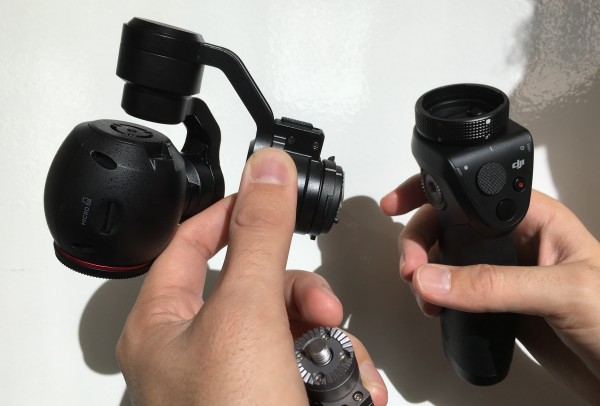
Initially the OSMO will come in a kit with the X3, or as a grip only option for existing X3 and X5 Pro owners.
So what makes OSMO so different? There are several other gimbals that, when combined with a GoPro Hero4 Black, cost about the same as the OSMO. The OSMO is very sleek in appearance and looks and feels like an integrated unit.
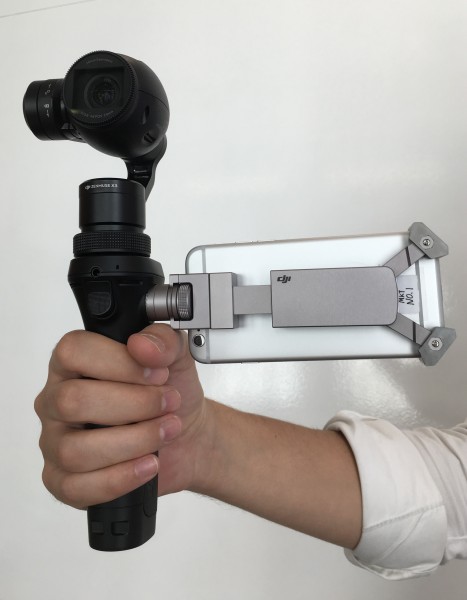
The OSMO has no screen of its own. Like most other action camera gimbals the OSMO needs a smartphone to see what the camera is up to. Connected via wi-fi to the company’s own DJI Go app you can see a live feed from the camera, trigger recording and set parameters.
The level of control via the app is excellent. Similar to a larger Ronin gimbal you can customise the speed and behaviour of the gimbal to suit your tastes. This level of easy customisation sets the OSMO apart from all other gimbals designed for smaller cameras. Software should be this way -other vendors please take note.
The gimbal can be used in follow mode, fixed, inverted, torchlight or selfie mode. These can all be accessed with the appropriate number of button presses on the handgrip.
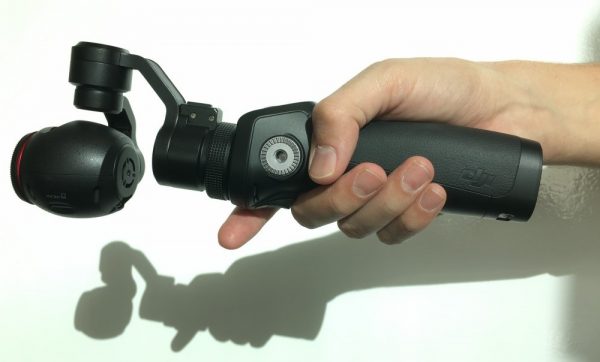
There is currently no way to directly stream the video feed from the smartphone, but you can connect a separate transmitter like a Teradek Bolt via the iPhone HDMI output. This could prove to be an interesting way to cover live events although I believe the feed is currently limited to 720P resolution.
Reliance on Wi-fi to control the OSMO does have its drawbacks. In heavily congested wi-fi areas maintaining a good connection between phone and camera could be problematic – although there is the ability to hop between 2.4 and 5.8 Ghz. I hope this isn’t an issue but in any case it would be good it DJI could explore tethered options for future models.
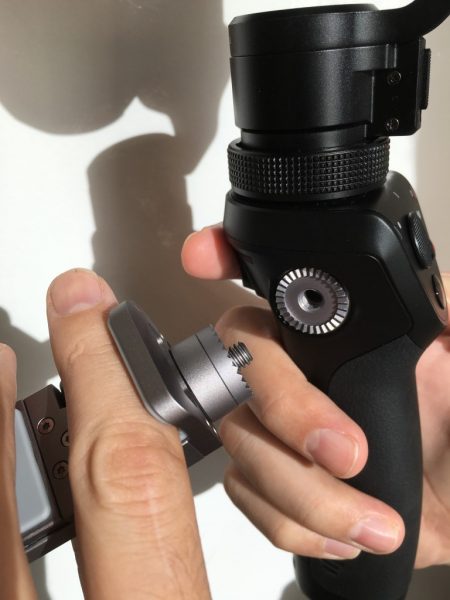
There is no 1/4 20 mounting hole on the base. Instead there is a threaded rosette in a slightly odd position on the side of the handgrip. This begins to make sense when you look at the range of accessories DJI have made to mount into it. There is clever phone holder, tripod, car mount, a bicycle mount, an extended arm and others. These give the OSMO some interesting mounting options.
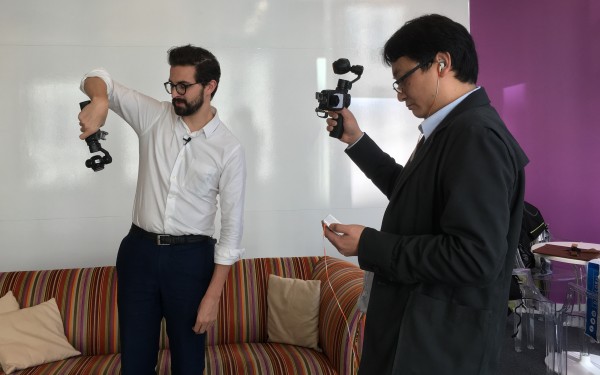
For audio there is a 3.5mm jack on the front of the handgrip. This allows you to mount mics like the Rode Videomic Pro or a wireless pack. At the moment the audio only has automatic gain control (AGC) – but hopefully this will change if more users request manual settings. I filmed the interview above with the OSMO and my Rodelink wireless system and there was a high pitch noise which, although easy to filter out, was annoying. I’m not sure what happened here, but hopefully production models of the OSMO won’t have any issues.
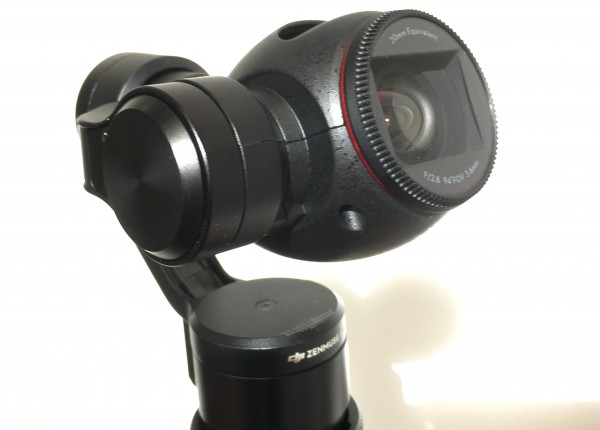
The X3 standard camera on the OSMO is similar to one with the Inspire 1, but painted black and with a new lens. The lens in the X3 is fixed focus, much like a GoPro, and has a fairly deep depth of field. Because it is being used handheld the focus of the lens is now optimised for distances between one metre and infinity. This does mean that very close up subjects will be out of focus – something you can see when the camera goes in for the close up shots in my video interview above. If you are intending to do a lot of close ups then I suggest you look at some kind of close-up lens option, or opt for the X5 camera which has proper focussing.
The camera on the X3 is now also capable of recording 120 fps in HD.
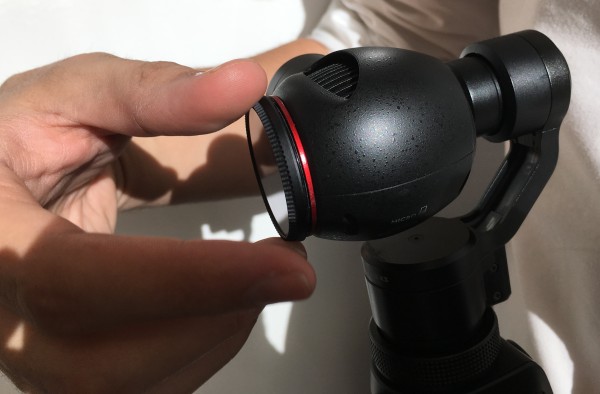
The stabilisation was impressive. The follow mode was smooth and the ability to lock orientations is very useful. There are digital encoders that mean that to set the yaw and pitch of the camera you can simply hold the camera in a position for a few seconds and it will remember it. As far as gimbals go this is pretty state of the art.
So who is the OSMO for? DJI clearly hopes that it will be popular with news organisations, bloggers and citizen journalists. But the OSMO has much wider appeal – imagine filming your toddler learning to walk, your road trip, your high school graduation, all with perfect stability. At the price it could well be the next ‘must have’ item on the Christmas list for gadget obsessives everywhere.
The Osmo with X3 camera is available for pre-order at store.dji.com for USD 649 and GBP 549 and will begin shipping October 15. The pricing and availability of the X5 versions and the grip only option is yet to be announced.
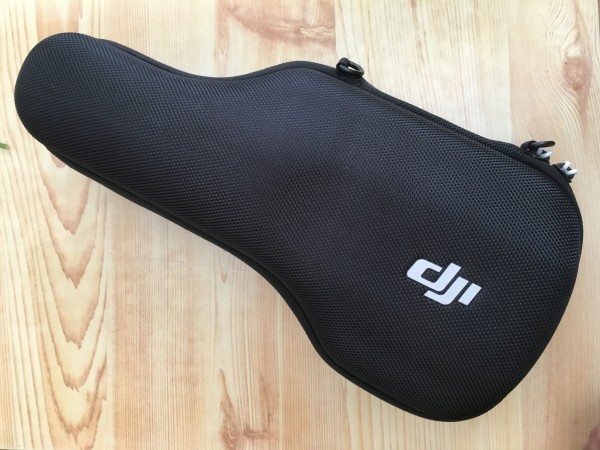
This from DJI:
DJI introduces the world’s first fully integrated, stabilized handheld 4K camera
New DJI Osmo is the first camera designed to create stable photos and videos in any condition
London, October 8, 2015 – DJI, the world leader in creative imaging technology, today announced the launch of the Osmo, an integrated camera and handheld stabilizer that opens the creative possibilities of cameras in movement.
Using DJI’s signature three-axis gimbal stabilization technology, the Osmo eliminates the shake of traditional handheld devices, creating cinematic shots in an easy-to-use, easy-to-set up form factor.
The modular format of the Osmo makes it fully compatible with DJI’s Zenmuse camera series, but comes standard with a 4K, 12-megapixel camera with a 1/2.3” sensor and a 94° field-of-view lens.
“DJI consistently refines the way cameras move in space – whether they are in the air or on the ground,” said Frank Wang, DJI CEO and Founder. “With the Osmo, we have created a camera specifically designed to capture a smooth moving image regardless of filming conditions.”
Intelligent controls built into the handle make changing between shooting angles, capturing photos or recording video effortless.
Creators can view live images of what the camera captures, adjust camera settings and control smart filming functions including –
Panorama – Take a picture and the camera will automatically pan around 360°, taking and stitching overlapping photos to create a panorama.
Long Exposure – Make handheld long-exposures crisp using the camera’s stabilization technology
Slow Motion – Capture slow motion shots at 120 frames-per-second (fps) up to 1080p
Its onboard universal mount works together with an included smartphone holder in addition to other optional accessories including a tripod, a bike mount or an extension arm.
The Osmo handle comes equipped with an on-board stereo microphone, as well as a 3.5mm audio jack for recording professional-quality external sound.
“Traditional handheld cameras are either shaky, or require bulky stabilizers that are difficult to set up,” said Paul Pan, DJI’s Senior Product Manager. “The Osmo moves the experience of handheld filmmaking from capturing what happened, to sharing expressive, smooth video that shows what an experience was like.”
The Osmo handle, which can be bought separately without a camera, is fully compatible with DJI’s existing Zenmuse series, making it the perfect accessory for everyone who already owns an Inspire 1 with a Zenmuse X3, a Zenmuse X5 Pro or a Zenmuse X5 Raw.
The Osmo is available for pre-order at store.dji.com for USD 649 and GBP 549 and will begin shipping October 15.
Additional Osmo accessories include –
Tripod – Place the Osmo securely on almost any surface.
Extension Rod – Reach out further for all new angles. Combine with the Tripod for added height. Bike Mount – Lock the Osmo to your bike for a new kind of bike movie.
Universal Mount – Add extra microphone or LED light to your Osmo.
Straight Extension Arm – Mount two accessories to your Osmo at the same time.



